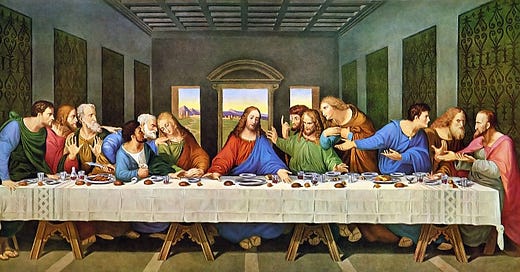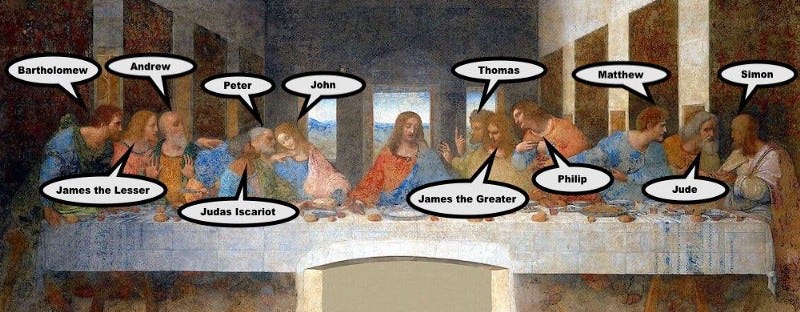Hello friends,
Thank you for subscribing and supporting my newsletter. Both free and paid subscriptions are available. The best way to support my work is through a paid subscription.
Does ‘The Last Supper’ Have a Hidden Meaning?
Raise your hand if you’ve read Dan Brown’s novel ‘The Da Vinci Code’ or for the cinephiles out there, watched the movie?
I confess that I first saw the movie, it overwhelmed me. I did not understand the premise quite well. Then I read the book.
Jesus marries Mary Magdalene, and their bloodline continues to live in France. Their descendants founded the Merovingian line of French kings. The Holy Grail. To top it all, the Knights Templar, and the secret European society the Priory of Sion guard this momentous secret.
I rewatched the film again. To say the least, I was enthralled.
I don't want to talk about the book’s premise here. Instead, I want to try and deconstruct the symbolism of Leonardo da Vinci’s magnum opus The Last Supper, and the conspiracy theories circling the Priory of Sion.
We would all be in a consensus when I say, ‘Da Vinci was an experimentalist and nonconformist.’ He cleverly mixed the biblical narrative with a bolder one— Judas Iscariot’s big betrayal.
That being said, Da Vinci made sure to follow certain iconographical standards as most of the general public was illiterate during that time.
So, who, and what, do we actually see in Leonardo’s Last Supper?
Jesus is sitting right in the middle with six apostles on each side. His left-hand reaches the bread and his right hand over his wine goblet. While the gospels Matthew, Luke, and Mark call this moment ‘institution of the Eucharist’ where Jesus breaks his bread and shares his wine with the disciples, John does not mention this.
Jesus announces his impending betrayal and how each of the disciples dramatically reacts.
Peter sits on the left side, holding a knife and protecting Jesus from his attacker.
Judas leans back in shock, holding the traditional purse of silver he’ll be granted for his betrayal of Christ. The upturned salt shaker in front of Judas is another reminder of him being a traitor and eventually dying of suicide.
The feminine figure sitting next to Jesus is John. Da Vinci inherited a similar representation of John used in the past —John often leaning or sleeping on Jesus’ chest with a feminine face and gestures. Dan Brown claimed John to be Mary Magdalene in the novel with whom Jesus married. Mary bore their child and moved to France with their daughter.
Does the Priory of Sion exist?
According to Dan Brown — yes, it did. He mentioned it in the preface of his book too. Around 1099, this society was born, and over the years, it included members like Sir Isaac Newton, Sandro Botticelli, Victor Hugo, and Leonardo da Vinci.
But here’s the catch — most scholars do not accept the Priory of Sion. They call it a hoax spread by a Frenchman named Pierre Plantard.
Plantard collaborated with the Nazis during the French occupation, made connections to the French throne, and spun a story out of it to establish Jesus’ lineage. He and his associates forged Les Dossiers Secrets, which made its way into the Bibliotheque Nationale and texts as fact.
Scholars considered it one of the biggest literary hoaxes of the 20th century.
What do you think about The Last Supper, and does it have any hidden meaning?





